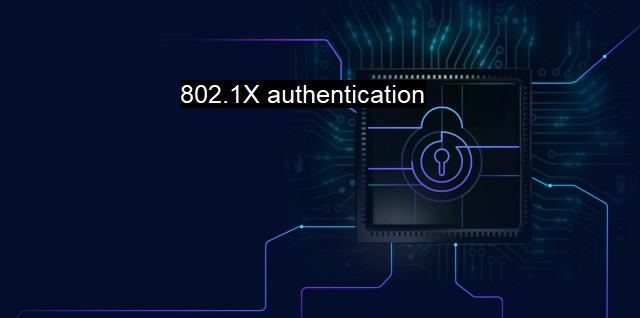What is 802.1X authentication?
The Essential Role of 802.1x Authentication in Cybersecurity: Securing Networks Against Evolving Threats
802.1X authentication is a standard network security protocol designed to allow secure connections to wireless or wired networks through credential exchanges among a supplicant, an authentication server, and an access device. The principal notion of applying cybersecurity protocols such as 802.1X within networks is to protect and shield system data from potentially harmful cyber threats.At its simplest, the policy named "802.1X" is a sophisticated endorsement instrument that is frequently used to mitigate cyber threats within WiFi (Wireless Fidelity) networks, requiring every unique unit linked to the network to be verified before the connection is established. it's not used solely on wireless networks; it's also utilized on Ethernet connections, proving a versatile security solution. Its creation arises from the pressing demand to secure communications between client devices and access points, delivering a massive contribution virus prevention and increasing an organization's cybersecurity measures.
When breaking down 802.1X and studying its intricate architecture, we recognize three fundamental components: The Supplicant, the Authenticator, and the Authentication Server. Firstly, the supplicant is the entity upon which the given credentials become authenticated. Conferring to diverse contexts, the supplicant might signify a computer or smartphone longing to connect to the network. Next, we have the authenticator component, intended to provide a protective layer amid the supplicant and the broader network, effectively blocking traffic until the supplicant's credentials became acknowledged. the Authentication Server assesses the supplicant's identity verified by critically evaluating the user's submitted information.
Where cybersecurity and antivirus contextual issues are concerned, applying 802.1X is pivotal in creating robust network security. As computer networks progressively serve as the epicenter for viruses, malware, and other cyber threats, adequately safeguarding these is paramount. suppose cybercriminals gain network access without requesting any specific authorization. They can manifest black hat activities, including installing advanced malware that steals vital data or even cripples an enterprise's daily function. Conversely, 802.1X commands each device to provide authentication, significantly limiting unauthorized jurisdictions that may promote cyber threats.
What also sets 802.1X apart and further drives its application as a sophisticated cybersecurity solution is its embodiment of the Radius and EAP Protocols. For widespread network administrators, combining RADIUS(Remote Authentication Dial-In User Service) and EAP(Extensible Authentication Protocol) simplifies their networks' protection task considerably. Fostering an ecosystem where secure, delimited, elaborate exchanges of identity take place is advantageous in prohibiting preliminary hostile in-roads.
IT administrators can distribute RADIUS servers various desktops within extensive networks preemptively to counter docking attempts over continuous operation periods. Incorporation of the EAP protocol concurrently signals the steering of varying encryption standards depending on the data sensitivity.
In a cybersecurity perspective, 802.1X outruns old-fashioned passwords as if successfully configured, the password doesn’t need to be consigned or stocked on a device. This severely limits a cyber attacker’s ability to recover user or admin passwords from physical appliances and IT endpoints. This superiority makes such communications and transactions safer and lowers the probability of cyber-crime that could jeopardize users' confidential details or even, in exceptional cases, grind corporations to a halt.
The utilization of 802.1X isn’t without negatives: it can cause radius failure and complexities on connecting non-standard/improvised equipment to the network. Consequently, a well-utilized business recovery approach should be prepared, as 802.1X configurations frequently lack allowances for these troublesome situations.
The implementation of 802.1X portrays a picture resulting in multiple benefits exceeding other minor setbacks for cybersecurity provisions. Building reliable information frameworks, effectively obstructing attacks from unwarranted intruder efforts, ascertains 802.1X as a cornerstone method in modern cybersecurity and explicitly lining anti-virus software workings. The continuous growth of risk vectors persistently affirms the need for rigorous protocols such as 802.1X.

802.1X authentication FAQs
What is 802.1x authentication and how does it enhance cybersecurity?
802.1x authentication is a network security protocol that provides port-based access control using an authentication server. It ensures that only authenticated devices can connect to the network, thus preventing unauthorized access and reducing the risk of cyber attacks.How does 802.1x authentication work with antivirus software?
802.1x authentication and antivirus software are separate security measures, but they can work together to enhance cybersecurity. The authentication protocol ensures that only authorized devices can connect to the network, while antivirus software protects against malware and other cyber threats that may attempt to infiltrate the network. Combining both measures can provide comprehensive protection against cyber attacks.What are the benefits of implementing 802.1x authentication in a network?
Implementing 802.1x authentication provides several benefits including increased network security, reduced risk of unauthorized access, improved access control, and better visibility into network traffic. It also ensures that only authorized devices can connect to the network, which helps prevent the spread of malware and other cyber threats.Are there any drawbacks to using 802.1x authentication for network security?
One potential drawback of 802.1x authentication is that it can be complex and time-consuming to implement, especially in larger networks. It may also require additional hardware or software to support the protocol. Additionally, if users forget their login credentials, they may not be able to access the network until their credentials are reset, which can cause inconvenience and downtime.| | A | | | B | | | C | | | D | | | E | | | F | | | G | | | H | | | I | | | J | | | K | | | L | | | M | |
| | N | | | O | | | P | | | Q | | | R | | | S | | | T | | | U | | | V | | | W | | | X | | | Y | | | Z | |
| | 1 | | | 2 | | | 3 | | | 4 | | | 7 | | | 8 | | |||||||